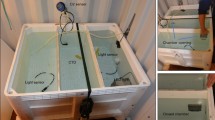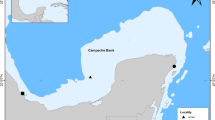Abstract
Adult euphausiids are difficult to capture with the nets typically used by oceanographers due in part to avoidance of the net. A cruise of the Southern Ocean GLOBEC program (NBP0103) in April/May 2001 permitted an evaluation of the efficacy of a high-powered strobe light (150 W) mounted on a 1-m2 multiple opening/closing net and environmental sampling system (MOCNESS) in reducing net avoidance. Three horizontal tows were made in Laubeuf Fjord, Marguerite Bay (western Antarctic Peninsula, 67.89°S; 68.30 W) on 28–29 May in an area that had a high abundance of adult krill (mostly Euphausia superba, Dana and a few E. crystallorophias, Holt and Tattersall). Each tow consisted of a series of paired down and up casts through a set depth interval (e.g. 50–90 m), with each successive net (335 µm mesh) sampling both a down and up cast. The strobe light was either “on” or “off” while each net was open, and when on, the light flashed at 4-s intervals. During a tow, four of the eight nets sampled with the strobe flashing and four sampled with the strobe off, in a random sequence. Total zooplankton displacement volume was significantly higher (P<0.05), on average by a factor of ~1.5, when the strobe light was on. The increased biovolume was due to the enhanced catch (factor of ~2) of adult krill (15–60 mm length). There was no enhanced catch of smaller krill (5–15 mm length: a mixture of E. superba, E. crystallorophias, and Thysanoessa macrura, GO Sars). In addition, the average length of the large krill fraction was not changed substantially with the strobe light on. These results suggest that krill avoidance of nets can be overcome by intense strobe lighting.



Similar content being viewed by others
References
Alhstrom EH, Thrailkill JR (1963) Plankton volume loss with time of preservation. Calif Coop Ocean Fish Investig Rep 9:57–73
Barkley RA (1972) Selectivity of towed-net samplers. Fish Bull (Wash DC) 70:799–820
Blaxter JHS, Parrish BB, Dickson W (1964) The importance of vision in the reaction of fish to driftnets and trawls. In: Kristjonsson H (ed) Modern fishing gear of the world, vol 2. Fishing News Books, London, pp 529–536
Boden BP (1969) Observations of bioluminescence on SOND 1965 cruise of R.R.S. Discovery. J Mar Biol Assoc UK 49:669–682
Bone DG (1986) An LHPR system for adult Antarctic krill (Euphausia superba). Br Antarct Surv Bull 73:31–46
Bucklin A, Wiebe PH, Smolenack SB, Copley NJ, Clarke ME (2002) Integrated biochemical, molecular genetic, and bioacoustical analysis of mesoscale variability of the euphausiid Nematoscelis difficilis in the California Current. Deep-Sea Res 49:437–462
Clarke MR, Pascoe PL (1985) The influence of an electric light on the capture of deep-sea animals by a midwater trawl. J Mar Biol Assoc UK 65:373–393
Clarke MR, Pascoe PL (1998) The influence of an electric light on the capture of oceanic cephalopods by a midwater trawl. J Mar Biol Assoc UK 78:561–575
Clutter RI, Anraku M (1968) Avoidance of samplers in zooplankton sampling. UNESCO Monogr Oceanogr Methodol 2:57–76
Davis CS, Wiebe PH (1985) Macrozooplankton biomass in a warm-core Gulf Stream ring: time series changes in size, structure, and taxonomic composition and vertical distribution. J Geophys Res 90:8871–8884
Doherty PJ (1987) Light-traps: selective but useful devices for quantifying the distributions and abundances of larval fishes. Bull Mar Sci 41:423–431
Everson I, Bone DG (1986) Effectiveness of the RMT8 system for sampling krill (Euphausia superba) swarms. Polar Biol 6:83–90
Foote KG (2000) Optical methods. In: Harris RP, Wiebe PH, Lenz J, Skjoldal HR, Huntley M (eds) Zooplankton methodology manual. Academic, San Diego, pp 259–295
Frank TM, Widder EA (1999) Comparative study of the spectral sensitivities of mesopelagic crustaceans. J Comp Physiol A 185:255–265
Greene CH, Wiebe PH, Burczynski J, Youngbluth MJ (1988) Acoustical detection of high density demersal krill layers in the Submarine Canyons off Georges Bank. Science 241:359–361
Hamner WM, Hamner PP (2000) Behavior of Antarctic krill (Euphausia superba): schooling, foraging, and antipredatory behavior. Can J Fish Aquat Sci 57[Suppl 3]:192–202
Hargreaves PM, Herring PJ (1992) The response of decapod and mysid crustaceans to artificially lighted trawls. J Mar Biol Assoc UK 72:621–631
Isaacs JD, Fleminger A, Miller JK (1969) Distributional atlas of zooplankton biomass in the California Current region: spring and fall 1955–1959. Calif Coop Fish Investig Atlas 10
Kils U (1979) Swimming speed and escape capacity of Antarctic krill, Euphausia superba. Meeresforschung 27:264–266
Kils U (1982) Swimming behavior, swimming performance and energy balance of Antarctic krill Euphausia superba. BIOMASS Sci Ser 3
Longhurst AR, Seibert DLR (1967) Skill in the use of Folsom’s plankton sample splitter. Limnol Oceanogr 12:334–335
Mauchline J (1980) Measurement of body length of Euphausia superba Dana. BIOMASS Handb 4:1–9
Neshyba S (1967) Pulsed light stimulation of marine bioluminescence in situ. Limnol Oceanogr 12:222–235
Orr MH (1981) Remote acoustic detection of zooplankton response to fluid processes, oceanographic instrumentation, and predators. Can J Fish Aquat Sci 38:1096–1105
Pascoe PL (1990) Light and the capture of marine animals, chapter 15. In: Herring PJ, Campbell AK, Whitfield M, Maddock L (eds) Light and life in the sea. Cambridge University Press, Cambridge, pp 229–244
Sameoto DD (1981) Quantitative measurement of euphausiids using a 120 kHz sounder and their in situ orientation. In: Suomala JB (ed) Meeting on hydroacoustical methods for the estimation of marine fish population, 25–29 June 1979. IIb. Contributed papers, discussion, and comments. The Charles Stark Draper Laboratory, Cambridge, Mass., USA, pp 847–875
Sameoto DD, Cochrane N, Herman A (1993) Convergence of acoustic, optical, and net-catch estimates of euphausiid abundance: use of artificial light to reduce net avoidance. Can J Fish Aquat Sci 50:334–346
Sameoto D, Wiebe P, Runge J, Postel L, Dunn J, Miller C, Coombs S (2000) Collecting zooplankton. In: Harris RP, Wiebe PH, Lenz J, Skjoldal HR, Huntley M (eds) Zooplankton methodology manual. Academic, New York, pp 55–81
Swinney GN, Clarke MR, Maddock L (1986) Influence of an electric light on the capture of oceanic deep-sea fish in Biscay. J Mar Biol Assoc UK 66:483–496
Watkins J (2000) Sampling krill, chapter 2. In: Everson I (ed) Krill biology, ecology, and fisheries. Blackwell, London, pp 8–19
Wiebe PH, Benfield MC (2003) From the Hensen net toward four-dimensional biological oceanography. Prog Oceanogr 56:7–136
Wiebe PH, Boyd SH, Cox J (1975) Relationships between zooplankton displacement volume, wet weight, dry weight, and carbon. Fish Bull (Wash DC) 73:777–786
Wiebe PH, Boyd SH, Davis BM, Cox JL (1982) Avoidance of towed nets by the euphausiid Nematoscelis megalops. Fish Bull (Wash DC) 80:75–91
Wiebe PH, Morton AW, Bradley AM, Backus RH, Craddock JE, Cowles TJ, Barber VA, Flierl GR (1985) New developments in the MOCNESS, an apparatus for sampling zooplankton and micronekton. Mar Biol 87:313–323
Wiebe PH, Copley N, Van Dover C, Tamse A, Manrique F (1988) Deep-water zooplankton of the Guaymas Basin hydrothermal vent field. Deep-Sea Res 35:985–1013
Wiebe PH, Stanton TK, Greene CH, Benfield MC, Sosik HM, Austin T, Warren JD, Hammar T (2002) BIOMAPER II: an integrated instrument platform for coupled biological and physical measurements in coastal and oceanic regimes. IEEE J Ocean Eng 27:700–716
Acknowledgements
We thank M-Q. Chu and L. Gray for their work in measuring the displacement volumes and making the krill length measurements, P. Hull for identifying the krill, and M. Dennett, A. Girard, K. Fisher, M. Taylor, and J. Zelag, E. Horgan, and others in the Raytheon Technical Support group for their assistance with the MOCNESS setup and during the tows. This work was supported by NSF Office of Polar Programs grant OPP-9910307. This is contribution 10982 from the Woods Hole Oceanographic Institution and 404 from the U.S. GLOBEC program.
Author information
Authors and Affiliations
Corresponding author
Additional information
Communicated by J.P. Grassle, New Brunswick
Electronic Supplementary Material
Rights and permissions
About this article
Cite this article
Wiebe, P.H., Ashjian, C.J., Gallager, S.M. et al. Using a high-powered strobe light to increase the catch of Antarctic krill. Marine Biology 144, 493–502 (2004). https://doi.org/10.1007/s00227-003-1228-z
Received:
Accepted:
Published:
Issue Date:
DOI: https://doi.org/10.1007/s00227-003-1228-z




